
|
Getting your Trinity Audio player ready...
|
The digital asset community must face the fact that so long as Binance continues to act as the poster boys for ‘crypto’ criminality, mainstream acceptance just isn’t going to happen.
There are certain guaranteed phenomena in the Star Wars cantina we call the ‘cryptocurrency’ sector, like how the BTC token’s price mysteriously crashes right before Tether does one of its quarterly ‘attestations’ (partly based on their need to quickly sell holdings for cash to momentarily create the illusion there’s something in its bank accounts).
Or how BTC’s price tends to jump ahead of the release of majorly bad news impacting one of the sector’s major players. Like how BTC was well below $30,000 on June 5 then suddenly spiked by over $2,000 late in the day, before swiftly retreating closer to $29,000 the following day.
It’s a matter of opinion as to what caused June 5’s BTC boost, but June 6’s slump came shortly after two major media outlets released notable crypto updates. Bloomberg reported that the U.S. Securities and Exchange Commission (SEC) was investigating the Binance exchange’s BNB token as a possible unregistered security, while Reuters published a lengthy exposé of the “at least $2.35 billion in illicit funds” that was reportedly laundered via Binance between 2017 and 2021. (That latter date reflects the moment when Binance belatedly—and begrudgingly—imposed basic know your customer (KYC) controls on its estimated 120 million global users.)
While Binance told Bloomberg that it “would not be appropriate for us to comment on our ongoing conversations with regulators,” it furiously pushed back against the Reuters report. Binance founder Changpeng ‘CZ’ Zhao issued a flurry of tweets calling the Reuters report “a huge waste of time and resources” and the company released a blog post rubbishing the article as “rife with falsehoods, massive leaps to conclusions” and reliant on “poor data.”
Binance also released purported emails between its spokesman Patrick Hillmann and Reuters reporters Angus Berwick and Tom Wilson (who co-authored an article last January dealing with Binance’s disinterest in complying with regulatory requirements). Initially, Hillmann’s replies to the Reuters emails largely involved Binance’s unwillingness to speak on the record while simultaneously urging the Reuters team to “rethink this unnecessarily hard line you are taking.”
Hillmann does eventually provide responses—we wouldn’t go as far as to characterize them as answers—to Reuters’ questions, primarily consisting of challenging the figures cited by the reporters and claiming that blockchain analytics firm Chainalysis supports Binance’s internal calculations. (How times change: in 2020, when Chainalysis reported that Binance had received more criminal funds than any other exchange, CZ accused the company of “bad business etiquette” and suggested that, as a Chainalysis client, “I guess we don’t pay enough.”)
We were told there would be no math
While Hillmann may not have given Reuters the full explanations they sought, the article’s release did help explain why, one week prior, Binance chose to issue a blog post titled “Crypto and Money Laundering: An Inconvenient Truth.” Hinting at the Reuters article’s imminent arrival, the post attempted to refute the popular notion of “crypto as a money-laundering paradise” and the even more widely held belief that Binance is “negligent in applying anti-money laundering and transparency protocols.”
Unfortunately, Binance’s blog post is a testimony to obfuscation, the apparent result of woeful ignorance, deliberate misrepresentation or both. For example, Binance cites the Chainalysis 2022 Crypto Crime Report, which came out in February, to make the claim that a mere 0.15% of “all transactions made with cryptocurrencies in 2021 … were associated with some type of illicit activity.”
But Chainalysis doesn’t analyze every single crypto token and only analyzes transactions that occur on the blockchain, which represent a tiny fraction of the transactions that occur off-chain, including those between customers on cryptocurrency exchanges such as Binance. Off-chain brokers such as OTC desks also handle seriously large volumes of digital assets that are outside the ability of Chainalysis to monitor.
Given these omissions, it’s pretty rich for Binance to claim that any individual who believes Binance enables money laundering “simply doesn’t understand the data nor how blockchain works.”
It’s also worth noting that the figures Chainalysis reports are subject to inflation as it belatedly identifies blockchain addresses linked to illicit actors. For instance, Chainalysis now says that the illicit activity percentage cited in the 2021 Crypto Crime Report is effectively twice as large as originally suspected.
Mo’nero, mo’ problems
Getting back to the Reuters report, we encourage readers to check out the full article, including its revelations on Binance’s former status as the go-to method for funding accounts on Russia’s darknet drug market Hydra, as well as the volume of stolen funds laundered through Binance by North Korea’s Lazarus hacking group.
There are plenty of other stories that poke iceberg-worthy gashes in Binance’s titanic compliance claims. For instance, Hillmann told Reuters that the path that digital assets took to reach the exchange was less important than “what we do after the funds are deposited” and that Binance employed various tools to “ensure that any illegal funds are tracked, frozen, recovered and/or returned to their rightful owner.”
That wasn’t quite the experience of one Steve Kowalski, an Australian who accidentally downloaded malware that allowed hackers to steal 1,400 BTC (worth around $16 million at the time) from his digital wallet. Most of this purloined BTC ended up in four Binance accounts, where it was exchanged for the so-called ‘privacy coin’ Monero.
The four accounts belonged to Brandon Ng, a U.S. resident who later claimed that he received a 1% commission for accepting the BTC deposits, converting BTC to Monero, then transferring the Monero to a trading partner he knew only as ‘MoneyTree.’ Ng conducted similar activity on the Poloniex exchange, which froze Ng’s account in 2019 after he withdrew over $1 million in Monero.
Binance took no such action against Ng, even though investigators hired by Kowalski were able to track his stolen coins to Ng’s Binance accounts. Asked in early October 2020 to freeze Ng’s accounts until the matter was resolved, Binance declined, telling the investigators that while “it is highly likely the paths leading to this account are malicious,” Binance couldn’t prove they were “facilitating laundering.” Pressed by the frustrated investigators to take decisive action, Binance admonished Kowalski’s rep about “several issues with your tone.”
Binance told Reuters that it had “instituted a temporary courtesy seven-day freeze” on Ng’s four accounts, but claimed that the exchange told Kowalski’s investigators that they “would need to have law enforcement reach out” to confirm Kowalski’s claims. When that seven-day deadline passed, Binance lifted the freeze on Ng’s accounts, allowing him to continue trading BTC for Monero and withdrawing.
Binance said law enforcement did contact the exchange on October 31 seeking a freeze of Ng’s accounts but Binance took no action because “this officer never responded to our follow-up questions.” Binance insists that its actions were correct because it didn’t receive what it claims it required in a timely fashion, which ignores the fact that law enforcement doesn’t always move at the speed of light or that Binance itself found it “highly likely” that the funds in Ng’s accounts were illicitly obtained.
(V)ery (P)ersistent (N)oncompliance
It’s worth remembering that Binance claimed to have blocked U.S. customers in mid-2019, after which Americans were supposed to be steered to the new Binance.US exchange. At the time, CZ—in a since-deleted tweet—gave U.S. customers a wink and a nod by stating that he considered VPNs to be “a necessity, not optional” for online activity.
Binance’s transparently false commitment to observing U.S. law was exposed in November 2020, when Forbes revealed the existence of internal company documents from 2018 detailing Binance’s strategy to evade U.S. regulatory scrutiny. Among the tactics to be deployed was the “strategic treatment of VPN use at Binance.”
Consider the above and then consider the veracity of Hillmann telling Reuters that “as a matter of policy, Binance discourages users from using VPNs to access its services.” We’re sure this policy is why CZ deleted his ‘I heart VPNs’ tweet, rather than his belated realization that publicly taunting U.S. federal agencies is akin to strolling through a bullfighting ring in a red mankini.
Know Your Criminal
Kowalski’s dilemma also begs the question: were Brandon Ng’s accounts with Binance’s main exchange or with its U.S.-based decoy? If the former, how was U.S. resident Ng able to access the site post-ban? If the latter, had Binance done any KYC whatsoever on Ng to determine whether the sudden flow of $16 million in and out of his accounts was in any way justified?
Reuters reported that in 2017, the year Binance launched, CZ had declared that the company’s strategy was “do everything to increase our market share, and nothing else.” By 2020, CZ was telling Binance staff that KYC rules were “unfortunately a requirement” of the exchange’s rapidly growing business. CZ’s lack of enthusiasm for KYC may explain why it took another year for the company to begin seriously addressing the issue (or at least pretending to).
Reuters also obtained a Binance staff group chat in which members of the exchange’s compliance team complained about the low hurdles of its KYC requirements. One individual was reportedly allowed to open an account after submitting ‘three copies of the same receipt from a meal at an Indian restaurant.’
Hillmann’s replies to Reuters’ numerous queries regarding Binance’s KYC failures were repeatedly met with the same copy-pasted text that starts with “Today, Binance KYC verification is highly sophisticated…”, which apparently makes up for the exchange’s past indifference to collecting any details on the people moving vast sums on and off its platform.
Hillmann insisted that “we require our users to go through the most rigorous KYC process in the industry.” This is the type of superlative response Binance employs whenever questions are raised about its commitment to the rules of whatever jurisdiction they operate in. It’s not enough for Binance to say their procedures meet industry standards. No, it’s the best in the business, despite reams of data indicating otherwise.
As a psychological profile of a certain World War II-era national figure put it, “people will believe a big lie sooner than a little one; and if you repeat it frequently enough people will sooner or later believe it.” (Ordinarily, we’d refrain from engaging in reductio ad Hitlerum but, hey, we’re not the ones associating our brand with swastika emojis.)
Binance’s blog warned that “media attacks on crypto and Binance will continue. Some large news organizations will continue to be influenced by actors seeking to limit the growth of crypto and Binance.” The reality is that Binance’s refusal to clean up its act means the ‘crypto’ sector will never be treated seriously by the masses, who know a crook when they see one.
Follow CoinGeek’s Crypto Crime Cartel series, which delves into the stream of groups from BitMEX to Binance, Bitcoin.com, Blockstream, ShapeShift, Coinbase, Ripple,
Ethereum, FTX and Tether—who have co-opted the digital asset revolution and turned the industry into a minefield for naïve (and even experienced) players in the market.

 11-17-2024
11-17-2024 




